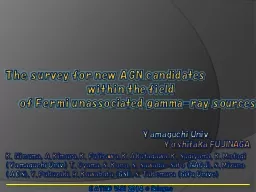

within the field of Fermi unassociated gammaray sources Yamaguchi U niv Yoshitaka FUJINAGA K Ninuma A Kimura K Fujisawa K Akutagawa K Sugiyama K Motogi Yamaguchi Univ ID: 429247
Download Presentation The PPT/PDF document "The survey for new AGN candidates" is the property of its rightful owner. Permission is granted to download and print the materials on this web site for personal, non-commercial use only, and to display it on your personal computer provided you do not modify the materials and that you retain all copyright notices contained in the materials. By downloading content from our website, you accept the terms of this agreement.
Slide1
The survey for new AGN candidates within the field of Fermi unassociated gamma-ray sources
Yamaguchi Univ.Yoshitaka FUJINAGA
K. Ninuma, A. Kimura, K. Fujisawa, K. Akutagawa, K. Sugiyama, K. Motogi (Yamaguchi Univ.) T. Oyama, S. Kono, S. Sawada-Sato (NAOJ), S. Mizuno (AES), Y. Fukuzaki, R. Kawabata (GSI), S. Takemura (Gifu Unive)
EATING VLBI 2014 @ Bologna Slide2
IntroductionFig.
Blazar Sequence ( Fossati et al. 1998 )Blazar ・・・
< Blazar’s SED >⇛ Blazar Sequence( Fossati et al. 1998 )This characteristic was discovered among bright blazars at radio Is this characteristic seen among all blazars ??FSRQLBLIBL
HBL
active galactic nucleus ( AGN ) with relativistic jets pointing almost along the line of sight.
Anti-correlation between and
It is necessary to
inspect that with taking account of faint
blazars
!!
We are going to increase the number of faint blazars
by using higher sensitivity VLBI system
!
EATING VLBI 2014 @ Bologna Slide3
Source selection~ γ-ray sample sources
~<
γ-ray sources selection criteria >Galactic latitude |b| > 5°Declination δ > -30°575 → 231 γ-ray sourcesFig. The distribution of our γ-ray samples 1873 γ-ray sources< Fermi 2nd catalog ( Nolan et al. 2012 )>
1298 sources
・・・
associated
806 sources are
‘blazar’ !!
575 sources
・・・
unassociated
<
Radio sample sources >
Used catalog :
NVSS
FIRST
→
we obtained 1211 radio sources.
(Condon et al. 1998)
(Becker et al. 1995)
EATING VLBI 2014 @ Bologna Slide4
Observation~ Observation system
~Optical-fiber-linked real-time VLBI system Recording speed
2048Mbps(previous : 128Mbps)16 times Band width !!→ 4 times higher sensitivity !! Real-time correlated processing Immediate results !!< Optical-fiber-linked real-time VLBI system >Angular resolution : 9.2 mas @8.4GHz ( Yamaguchi-Tsukuba : 804km )Noise level : ~2 mJy ( on source time : 3 minutes )< Our observation’s spec >SNR (signal to noise ratio) is over 6 → Detection!!We completed 845 sources out of 1211 samples.
EATING VLBI 2014 @ Bologna Slide5
EATING VLBI 2014 @ Bologna Results
~ Detection sources ~ We detected 29 sources
!! brightness temperatures of detected sources exceed 10 to 6 K at least!! →This result show detected sources are possible AGN candidates due to such high brightness temperature. Slide6
EATING VLBI 2014 @ Bologna Results
~ Counterparts to detected sources ~<
Used catalog > 2MASS WISE SDSSVLBI observation has high positional accuracy.With using radio coordinate,we searched for counterparts at other wavelength.In this presentation,we focus on WISE counterpart.WISE counterpart : 22 sourcesSlide7
DiscussionWe discriminated blazars from detected sources
using the method described in Massaro et al.(2012)Massaro et al. (2013)A characteristic distribution of blazars with γ-ray emission in WISE color – color space.
< WISE Gamma-ray Strip ( WGS ) >We discriminated blazars based on their method.EATING VLBI 2014 @ Bologna ( For detail of this method, please see their report. )They classified blazars based on WISE Gamma-ray Strip ( WGS ) and parameter ‘s’. Slide8
Discussion< Our results >We applied the method
described by Massaro et al (2013) to 14 sources.Nine sources are possible blazars
!!threshold :EATING VLBI 2014 @ Bologna Slide9
Peak flux : 0.272[Jy/beam]Beam size : 9.7 × 3.4 [mas]Image rms : 2 [
mJy]Peak flux : 0.249[Jy/beam]Beam size : 2.6 × 0.9 [mas]Image rms
: 2 [mJy]Peak flux : 0.204[Jy/beam]Beam size : 1.5 × 0.37 [mas]Image rms : 2 [mJy]Discussion< Results of VLBA Observation >We estimated the spectral indices of detected sources with using the results of multi-band observations by VLBA.( Typical blazar : α<0.3;“ACTIVE GALACTIC NUCLEI”Krolik et al. )NVSS J030727+491510 : α=0.07Jet component in the northeast direction.EATING VLBI 2014 @ Bologna
~
J0307+4915
~
Spectral index α:
Beam size [
mas
] × [
mas
] :
9.7 × 3.4 2.6 × 0.9 1.5 × 0.37
※
Convolved beam size of
5 [
mas
]
× 5 [
mas
] Slide10
Discussion< Correlation diagram>
Radio flux at 1.4GHz – 1 GeV – 100 GeV Photon flux→ the region of detected sources are
similar to that of HSP BL Lacs1 GeV – 100 GeV Photon index–1 GeV – 100 GeV Photon fluxEATING VLBI 2014 @ Bologna → the region of detected sources are similar to that of FSRQSlide11
Conclusion Search for new faint blazars with γ-ray emission
29 radio sources with high brightness temperature e-VLBI observation for radio sources within the positional error of unassociated γ-ray sources in Fermi 2nd catalogNine
detected sources are possible blazars ( by Massaro way )J0307+4915(detected source) is possible blazar( from the viewpoint of spectral index )Different trend from known blazars ( from correlation diagrams )EATING VLBI 2014 @ Bologna